|
|
Updated as per Butterflies and Moths of North America website, formerly USGS, July 24, 2010
Updated as per James P. Tuttle's The Hawk Moths of North America, July 24, 2010
|
Pend Oreille County, Washington
Sphingidae
Seventeen Sphingidae species are listed for Washington. Not all of the species are reported or anticipated in Pend Oreille County.
It is hoped that this checklist, with the thumbnails and notes, will help you quickly identify the moths you have encountered.
A "WO" after the species name indicates that I have no confirmed reports of this species in
Pend Oreille County, but I (William Oehlke) expect that this moth is present. A
USGS indicates the moth is reported on the USGS website and/or in Moths of Western North America,
#2. Distribution of Sphingidae of Western North America, revised,
an excellent little booklet available through Paul Opler.
Please help me develop this list with improved, documented accuracy by
sending sightings (species, date, location), preferably with an
image, via email to
Bill Oehlke.
Sphinginae subfamily
Sphingini tribe:
 |
This species is probably present (unreported) and larvae feed on tomatoes and go by the common name of
"Tomato Hornworms". |
 |
There is a broad greyish-white forewing costal area. Most of the rest of the forewing is a dark slate grey
with some thin black streaks. There are some white areas near the outer margin.
|
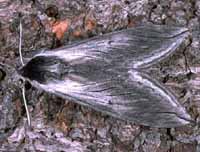 | The upperside of the forewing is dark grey to black with a
paler costa and pale area from the base to the wing's centre.
Prefered habitats include montane woodlands and mixed chaparral-type
vegetation. |
 |
Sphinx vashti
WO, the Snowberry Sphinx.
The upperside of the forewing has a narrow black subterminal line
bordered by a white inverted V-shaped line on the outside, and a
black line running inwards from the apex of the wing.
It is most often found in montane woodlands and along streamcourses. |
Smerinthini Tribe:
 |
Pachysphinx modesta
WO,
the Modest Sphinx or Poplar Sphinx,
This large poplar/willow feeder probably flies in Pend Oreille County.
They are a heavy bodied species.
|
 |
The grey-blue eyespot of the hindwing gives this species its name.
Larvae feed on birches, willows, cherries and oaks.
The outer edge of the forewings is quite scalloped. |
 |
This small species is probably widespread and common. This species ranges across North America.
The hindwings have a small blue eyespot ringed with black on a yellow background.
|
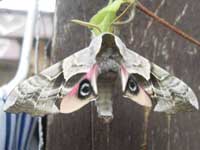 | Larvae feed on poplars, aspen and willows.
Note different shape of double arced forewing pm line compared to the straighter pm line of cerisyi, which it replaces in WA.
S. ophthalmica has smoother scalloping of the fw outer margin.
|
Macroglossinae subfamily
Dilophonotini tribe
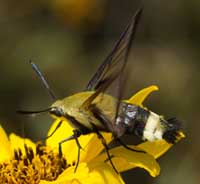 |
Hemaris thetis WO, the Thetis Clearwing Moth or Bee Hawk Moth
Hemaris thetis is a very variable species, but almost always the abdomen sports contrasting black and
yellow hairs, the ventral surface being quite black. The legs also tend to be quite dark and there is a black mask
running across the eye and along the sides of the thorax. |
Macroglossini tribe
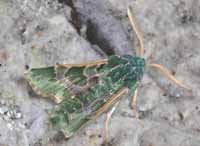 |
Arctonotus lucidus
WO, the Pacific Green
Sphinx Moth or Bear Sphinx Found to the northwest, east and south,
this species is probably present.
It tends to be an early spring flier, on the wing in the early
evening. It comes to lights at night. |
 |
Hyles gallii WO,
the Bedstraw Hawk Moth or Gallium Sphinx.
This forewing is dark brown with a slightly irregular cream-coloured transverse line. The outer margin is grey.
There is a bright pink band on the hindwing. If
you have Gallium or Epilobium, you might have
localized populations of this species. |
 |
Hyles lineata WO, the White-lined Sphinx
This species is very widespread. It can be seen flying during the day,
into the evening and also at night.
The highly variable larvae are often found in people's gardens. |
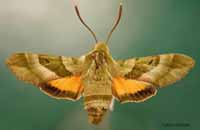 |
The upperside of the forewing is greenish gray; the median area may be dark or pale.
The upperside of the hindwing is bright orangish yellow with black borders. This day flier,
April-June, prefers oak woodland and pine-oak woodland in foothills.
Moths nectar at a variety of flowers in the afternoon.
|
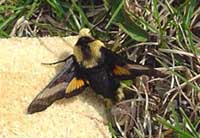 |
Proserpinus flavofasciata WO,
the Yellow-banded Day Sphinx
Fw upperside is medium to dark brown to almost black with a faint to distinct white median band. Hw upperside is dark brown with a
wide orange median band which may not reach the inner margin. The moth mimics a bumblebee. |
|
|
Enjoy some of nature's wonderments, giant silk moth cocoons.
These cocoons are for sale winter and fall. Beautiful Saturniidae moths will emerge the following spring and summer.
Read Actias luna rearing article. Additional online help available.
Use your browser "Back" button to return to the previous page.
This page is brought to you by
Bill Oehlke and the
WLSS. Pages are on space rented from Bizland. If you would like
to become a "Patron of the Sphingidae Site", contact Bill.
Please send sightings/images to Bill. I will do my best to respond to
requests for identification help.
 | 
Show appreciation for this site by clicking on flashing butterfly to the left.
The link will take you to a page with links to many insect sites. |
